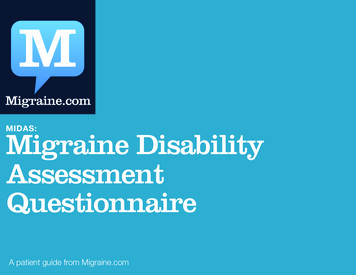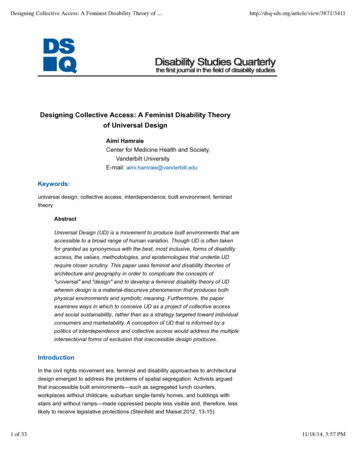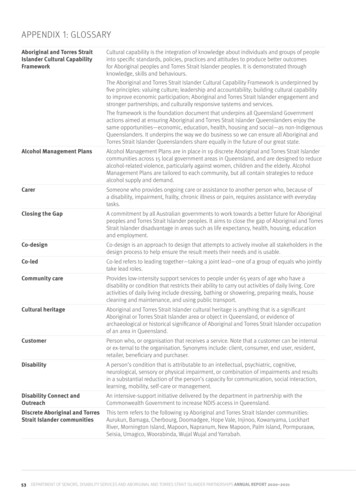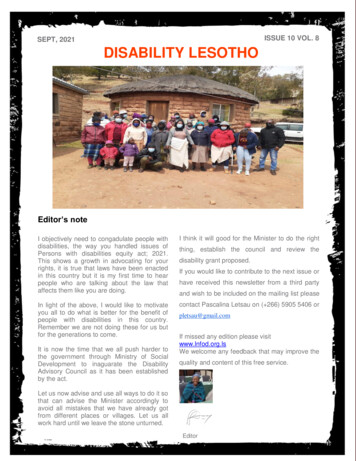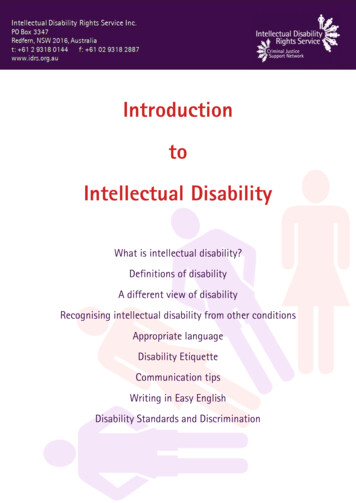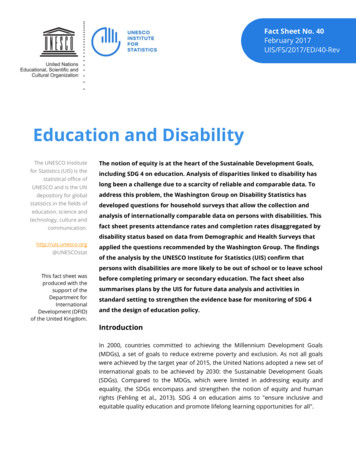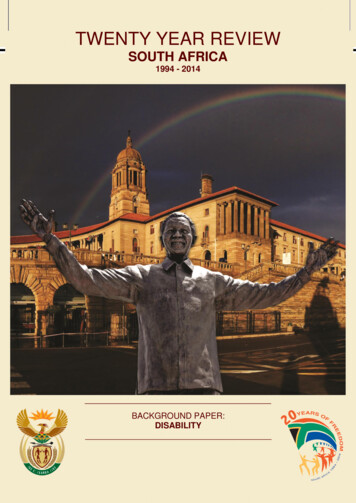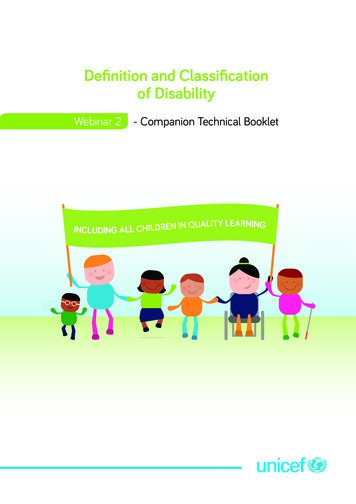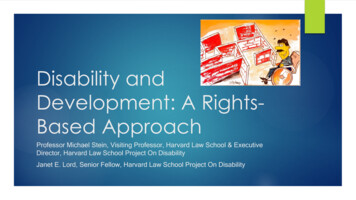
Transcription
Disability andDevelopment: A RightsBased ApproachProfessor Michael Stein, Visiting Professor, Harvard Law School & ExecutiveDirector, Harvard Law School Project On DisabilityJanet E. Lord, Senior Fellow, Harvard Law School Project On Disability
Learning Objectives Understand the framing of disability in human rights law and indevelopment policy & how disability rights are reflected in internationalstandards to inform inclusive development. Identify the challenges and barriers persons with disabilities commonlyface in claiming their human rights and the benefits of development inparticular, and using an intersectional lens. Apply key concepts and principles to assess development projects andtheir disability impacts2
Discussion: Can we define disability? Who is disabled? Does the CRPD define disability?3
Discussion: Myths and Stereotypesabout Different Types of Disadvantage4 What myths or stereotypes are associated with Disability? Persons with disabilities? Persons with different types ofdisability? Women? Men? Girls? Boys? What impact do these perspectives have on inclusion in development? For persons with disabilities?
What are the framings of disability inconversation? In the media? In lawand policy?5
6
7
8What Model of Disability?From electorallegislation:Example 1:“Where no accessiblelocation is available to serveas a polling place, a politicalsubdivision must provide analternate means of casting aballot on the day of theelection.”Example 2:“The right to vote shall bedenied to: 4) One who is insane orretarded”From electorallegislation:Exercising political rightsshall be suspended forthe following persons: (2) Those who arebeing treated formental illnesses and forthe period of theirtreatment.From internationaldocument:Disability is an evolvingconcept. Disability resultsfrom the interactionbetween persons withimpairments andattitudinal andenvironmental barriers thathinders their full andeffective participation insociety on an equal basiswith others.
Global Response Conventionon the Rights of Persons withDisabilities – negotiated between 2002-2006 Adopted in 2006 More than 800 representatives fromdisability organizations around the worldparticipated in drafting process.9
CRPD Overall Structure10 Preamble Introductoryarticles (Articles 1 & 2) Articles of general application (Articles 3-9) Specific articles (Articles 10-30) Implementation and monitoring measures (Articles 3140) Final articles (Articles 41-50)
CRPD Content & Issues11 A “core” international human rights treaty Legally binding New paradigm – social model of disability Comprehensive content Elaborates existing human rights in the context of disability - does notcreate new or “special” rights for people with disabilities – intentionwas to situate the human rights of persons with disabilities within theexisting human rights framework compromised of the UDHR, ICCPR,ICESCR
Progressive development of humanrights law General principles (Art 3) & Art. 4(3) Right of equality & non-discrimination (Art 5) together with the duty to providereasonable accommodation to persons with disabilities (necessary andappropriate adjustments not imposing a undue burden) (Art 5 & 2) Awareness raising (Art 8) Accessibility (Art 9) Legal capacity (Art. 12) Others .Art. 21, 24, etc12
CRPD Drafting Process13
Current status20 States Parties for entry into force May 3 CRPD & OP entered into force (2008) CRPD Signatories: 161CRPD Ratifications/Accessions: 177 includes EUOp Proto. Signatories: 92 Op. Prot. Ratification/Accessions: 92 14
Setting the Broad Context for Thinking about Exclusion inDevelopment on the Basis of Disability15
16What the research tells us 15% of the world’s population havea disability – most of them live indeveloping countries. Disability isdiverse NOT homogenous.Persons with disabilities face higherrates of poverty compared to otherpersons.Significant over-representationamong extreme poor. Persons with disabilities face seriousobstacles in attaining the benefits ofeconomic development andescaping poverty on account of: discrimination in employment; limited access to transport; and lack of access to the resourcesthat can facilitate selfemployment and livelihoods.
Law and Policy Context for DisabilityInclusive Development Convention on the Rights of Persons withDisabilities, 2006, Art. 5 (Non-discrimination);Art. 32 and related articles Impetus for bilateral donors to adoptdisability policies, guidelines, strategies USAIDDisability Policy (2004)(under revision currently) DFIDDisability Framework DFATStrategy for Disability InclusiveDevelopment EU andothers 17Impetus for multilateral donors toadopt disability policies, guidelines,strategies UNDevelopment Group, Guidelineson Disability Inclusion UNDP(Independent EvaluationOffice Global Assessment onDisability Inclusive Development) IASCTask Team for Development ofGuidelines on Disability Inclusion inHumanitarian Action
What Does Disability Inclusive DevelopmentLook Like in Programming? Democracy and Governance Public health Water & sanitation programming (Hazel Jones, recent World Bank Guidance Note)Economic development Teacher training (Harvard Law School Project on Disability & Perkins International)Infrastructure HIV/AIDS (World Bank/Yale School of Public Health)Education Disability law reform, working on election access, building DPO capacity for advocacy,documenting human rights violationsMicrofinanceHumanitarian aid Efforts to promote inclusion in emergency response (Humanitarian Charter on Inclusion, newIASC Guidelines process on disability inclusion
19SDGs: Goals and Targets to Ensure Development Benefits All
DisabilityInclusion in theSustainableDevelopmentGoals20 Disability inclusion on the 2015-2050Development Agenda 7 targets address persons with disabilities ineducation, accessible schools, employment,accessible public spaces and transport,empowerment and inclusion, and datadisaggregation. 6 targets refer to persons in vulnerablesituations, which are understood to includepersons with disabilities. Universal targets must also be achieved forpersons with disabilities. 2 other targets address discrimination, a majorcause of inequality and unequal access toopportunities and services for persons uments/sdgs/disability inclusive sdgs.pdf
Gender, Age inthe SustainableDevelopmentGoals21 The SDGs make a the commitment that "allindicators should be disaggregated by age“ Goal 3: "ensure healthy lives and promotewell-being for all at all ages". Goal 5 is dedicated to gender: "achievegender equality and empower all womenand girls“ – and it has an age-inclusive remit,supporting both older men and women torealize their potential and, in the process,maximizing opportunities for prosperity andwellbeing for all.
World Bank Group Environmental andSocial Framework (Sept. 2018operational)22
Disability Inclusion and the World Bank 23Supporting the mainstreaming of disability in WB activities: Including disability in the Bank’s policies, operations andanalytical work Building internal capacity to support clients in implementinginclusive development programsTwin-track approach to disability-inclusion: Ensuring that persons with disabilities participate in and benefitfrom operations and projects across the WB in general Promoting targeted projects responding to specific sectors andgaps directly related to persons with disabilities
Disability Inclusion in the ESF &Directive The ESF and Directive: Strengthenthe Bank’s commitment to theidentification of vulnerable anddisadvantaged groups as part ofenvironmental and social assessment withspecific recognition of persons with physical,mental or other disabilities.24
ESF Vision Statement on Inclusion & LegalFramework for Disability Inclusion Inclusion means empowering allpeople to participate in, and benefitfrom, the development process.Inclusion encompasses policies topromote equality andnondiscrimination. Inclusion as improving the access of allpeople to services and benefits suchas education, health, socialprotection, infrastructure, affordableenergy, employment, financialservices and productive assets. ESF. A Vision for SustainableDevelopment, para. 3.25 Full and effective participation & inclusionin society. Identify and modify or abolish laws &practices that constitute disabilitydiscrimination. Consultation and active involvement ofpersons with disabilities in decision-making. Access, on an equal basis with others, tothe physical environment, to transportation,to information and communications, andto other facilities and services open orprovided to the public, both in urban andin rural areas. This includes the identificationand elimination of obstacles and barriers toaccessibility. Convention on the Rights of Persons withDisabilities, arts. 3, 4, 5, 9
ESS1 – Discrimination as Social Risksand Impacts Socialrisks and impacts under ESS1include “any prejudice or discriminationtowards individuals or groups in providingaccess to project benefits, particularly inthe case of those who may bedisadvantaged or vulnerable.”26
Directive – Explicit Recognition ofPersons with Disabilities Personswith disabilities fall withinthe parameters of individuals orgroups who may be:“disadvantaged or vulnerable.” World Bank Directive, Addressing Risks and Impacts on Disadvantaged or Vulnerable Individuals orGroups, August 4, 2016.27
“Disadvantaged or vulnerable” – personswith disabilities, older persons, LGBTI persons,others “[I]ndividuals or groups who, by virtue of, for example, their age, gender,ethnicity, religion, physical, mental or other disability, social, civic or healthstatus, sexual orientation, gender identity, economic disadvantages orindigenous status, and/or dependence on unique natural resources, maybe more likely to be adversely affected by the project impacts and/ormore limited than others in their ability to take advantage of a project’sbenefits. Such an individual/group is also more likely to be excludedfrom/unable to participate fully in the mainstream consultation processand as such may require specific measures and/or assistance to do so.This will take into account considerations relating to age, including theelderly and minors, and including in circumstances where they may beseparated from their family, the community or other individuals uponwhom they depend.” Source: World Bank Directive, Addressing Risks and Impacts onDisadvantaged or Vulnerable Individuals or Groups, August 4, 201628
Guidance on “persons withdisabilities”29 “Persons with disabilities” include individuals “who have long-term physical, mental, intellectualor sensory impairments which in interaction with various barriers may hinder their full andeffective participation in society on an equal basis with others.” Not exhaustive and is an “evolving concept.” Diversity of disability recognizes that disability is not restricted to one type of impairment, suchas physical disability. Disability is heterogenous and persons with disabilities have differentiatedneeds in relation to barrier-free access. Disability is intersectional. The conceptualization of disability in international instruments recognizes that disability is not anarrowly defined medical issue as traditionally emphasized, but a manifestation of social andenvironmental barriers that inhibit full inclusion and participation, including in development. Source: Convention on the Rights of Persons with Disabilities, art. 1. See also World Report on Disability (2011)
Art. 5CRPDSection3, para.5(a)DirectiveESFVisionStatement,ESS1, 2,10Non-discrimination on the basis ofdisability30
Borrower Guidance on DisabilityDiscrimination It prohibits both intentional and overt (direct)discrimination and non-intentional (indirect) discriminationor exclusion on the basis of disability.Indirect discrimination arises from practices which areneutral in nature but discriminatory in effect. Usually, thesepractices are embedded in institutional policies, normsand standards.Persons associated with persons with disabilities, such asfamily caregivers or children who have parents withdisabilities, are protected from discrimination on the basisof disability on the basis that the CRPD protects against“all forms of discrimination.”31
Borrower Guidance on Nondiscrimination & Disability inEnvironmental and Social Assessments The duty to provide reasonable accommodation means an essentialpractice to alleviate the disadvantage that may arise for people withdisabilities in the application of conventional requirements or systems. Reasonable accommodation aims to bring about adaptation andchange of the environment in order to remedy or mitigate the detrimentassociated with the interaction between environment and impairment. Reasonable accommodation is an individual measure. Other positive measures associated with ensuring non-discriminationinclude accessibility measures, or “universal access” in the ESF.32
Case Studies - Introduction33
34ESS1 & DirectiveTOR asures TOR Review Identification: Who in the projectcontext? How to identify? Whatbarriers to identification? Risk Analysis: What risks? What riskfactors? Differentiated measures: What typesof measures are needed for personswith disabilities? For older persons?Others? What reasonableaccommodations? What accessibilityconsiderations? What other supportsand positive measures?
Specific and Differentiated Measures“Specific” measures may berequired to facilitateparticipationAccessible &InclusiveInformationAccessible &Safe d measures maybe required to mitigateadverse impactsAction PlansSpecificMeasures35Specificcompensatoryplans (e.g.,disability, olderwomen)Accessible DesignDM
36Strategies forelectoralinclusion?-What barriers?-How to removethem?-What framework forthinking about entrypoints for electoralaccess for personswith disabilities?
37Globally, an estimated1 billion people lack an IDWithout an ID,people struggle to access:Financial servicesSocial Safety NetsHealth servicesEducationTravel & MigrationMobile services
38Digital ID serves as a foundational platformINDIA: In six years, financialinclusion increased from35% to 80%PERU: ID verifiesbeneficiaries to accessuniversal health insurance,and enables tracking ofvaccinesFinancial inclusion Removing barriers through eKYCEnabling digital paymentsReducing risk for creditHealth THAILAND: UniversalWomen’s empowermentHealth insurance for universal healthcareUnique ID for healthcare delivery &tracking, incl. vaccinations Direct payments & transfers towomen in the householdEnforcing child marriage lawsRegional integration Safe & orderly migrationCross-border services &paymentsDigital ID PlatformSocial protection Better targeting of beneficiariesEliminating leakages ‘ghosts’Enable digital G2P paymentsEducation Removing barriers toenrollmentImproving EMISID system enablesstateless children toattend school
Developing countries rolling out identification systems facecommon challenges related to the quality of systems & IDsLow Coverage& AccessibilityLegal &RegulatoryTechnology &InfrastructureGovernance &Harmonization Fees, indirect costs, andconvoluted processescreate barriers toaccessing identification Lack legal & regulatoryframeworks to cover IDagency mandates,privacy, and dataprotection Prevalence of legacymanual paper basedsystems Systems tend to befragmented, with siloministries engaging induplicative or one-offefforts Disproportionate impactsof lack of access forwomen, displaced personsand other marginalizedgroups Where frameworks are inplace, they are oftendated, inadequate, andface issues withimplementation Where digital systems exist,increasing reliance onsmartcards which oftenresults in vendor lock inand high cost Lack of connectivity andphysical infrastructure; e.g.in storing/managing dataand in remote authentication Lack of coordinatione.g. between civilregistries and digitalidentification.
Framing the Legal Context forDisability Inclusive NationalIdentification Non-Discrimination and reasonable accommodation for persons with disabilities Failing toaccommodate persons with disabilities in national ID programs is discrimination. Accessibility of ICT for persons with disabilities: Accessibility to information andcommunication technologies is required; applies to procurement of identificationtechnologies. Recognition as a person before the law for persons with disabilities: Article 12 mandatesequal recognition before the law and legal capacity; requires that supported decisionmaking be provided to persons with disabilities where needed. Birth registration of children with disabilities: It is the right of every child to be registeredimmediately after birth. This is an important protective measure that also opens upopportunities in education, health, social protection and access to other services. Identity of children with disabilities: The CRC recognizes the right of the child “to preservehis or her identity (including nationality, name and family relations)” and, “where a child isillegally deprived of some or all of the elements of his or her identity, to provide appropriateassistance and protection, with a view to re-establishing speedily his or her identity.” Thisright is likewise specifically guaranteed for children with disabilities in the CRPD. Other: Identity documents for refugees with disabilities and for migrants with disabilities.Refugee Convention; Migrants Convention
ID4D Cycle & Points of Entry for DisabilityInclusionAccessible Design &ProcurementStakeholder OutreachDisability gationof lehelp desksor hotlinesDPOOutreachAccessible siteselectionInclusivebudgetingInclusivemessages &imagesID4DCycleTargeted infosessionsCodes ofconduct forenrolmentDisabilityinclusivemonitoring& dationsMonitoringFlexibleProcedures
42Mitigation HierarchyExample: Infrastructure & Physical Barriers (1) Anticipate and avoid risks andimpacts; (2) Where avoidance is not possible,minimize or reduce risks and impactsto acceptable levels;Address hazards/alter design to minimize risk. (3) Once risks and impacts have beenminimized or reduced, mitigate; andIntroduce safety measures/accessibility options. (4) Where significant residual impactsremain, compensate for or offsetthem, where technically andfinancially feasible.Identify potential hazards or inaccessible designdimensions. Identify protection issues.Offer alternatives/compensate.
Transport – Rio City Project & LimaMetro Project (Disability case study)43 1994 - Rio City Project 1 initiated. DPO lobbied forchanges to address accessibility issues. Project adopted a Universal Design principle,contracted Independent Living Center of Rio deJaneiro (CVI-Rio), with significant experience inaddressing accessibility, to assist with the project(e.g., constructed ramps at sidewalks to facilitatemovement for people with disabilities, and forthose pushing baby carriages and grocery carts.Texture coded pathways were constructed forvisual impaired road users. Street fixtures, such aslamp posts, sign posts, litter baskets, benches,etc., were repositioned and resized to meetaccessibility standards). Rio City Project 2 used the experience inaddressing universal accessibility to betterincorporate accessibility issues at design stage.
Resettlement – Older persons withdisabilities44Resettlement (1) Anticipate and avoid risks andimpacts; (2) Where avoidance is not possible,minimize or reduce risks and impacts toacceptable levels; (3) Once risks and impacts have beenminimized or reduced, mitigate; and (4) Where significant residual impactsremain, compensate for or offset them,where technically and financiallyfeasible.Identify affected older persons/families and risks andimpacts. (Anticipate challenges in identification)Plan and consult with affected households to minimizerisk. (Anticipate the need for measures to supportparticipation of older persons)Provide specific measures to mitigate risks tohouseholds. (e.g., Accessibility planning)Compensate to cover extra resource needs(accessibility measures in new housing, costs related tomaking new environment accessible).
ESS10 - 3 Domains of inclusiveengagement Disclosure:Receiving information on an equal basis with others,including by providing information in accessible formats and technologiesappropriate to different kinds of disabilities in a timely manner and withoutadditional cost; accepting and facilitating the use of sign languages,Braille, augmentative and alternative communication.Stakeholder engagement: Designing and implementingprocesses that are accessible to stakeholders with disabilities; anticipatingand taking mitigating measures to avoid barriers; identification & removalof barriers to participation.Grievance redress:Non-discrimination and equality of accessrequires Borrowers to ensure that persons with disabilities have access toall phases of the grievance process in a timely fashion. It further requiresthat such access not be disproportionately delayed relative to others, forinstance in order to receive reasonable accommodations.45
Differentiated Measures - AccessibilityConsiderations for Borrowers46 Consult closely with organizations of persons with disabilities to identify accessibility requirements. Printed materials: Ensure that materials are made available in the formats and languages that arerequired to ensure full participation–for example, documents in electronic format, Braille, largeprint, easy-to-read-and-understand formats. Visual aids: When using slide presentations, photographs, diagrams, maps, videotapes and othervisual aids, ensure that information conveyed is communicated clearly, so that blind or visuallyimpaired participants can follow, and in alternative formats–for example by providing text anddescriptions of images displayed. Verbal communications: In conducting face-to-face and telephone meetings or training sessions,ensure that adequate time is allocated, and that persons who are deaf, deaf-blind, and thosewith intellectual disabilities understand what is being said by others and can communicate theirown ideas, through arranging for sign-language interpretation, real-time captioning orcommunications assistants. Locations: In selecting venues for meetings, training sessions or other events, ensure thataccessibility requirements are met. Transport to consultation venues: Inaccessible or expensive transport is often a barrier.
47
Disability law reform, working on election access, building DPO capacity for advocacy, documenting human rights violations Public health HIV/AIDS (World Bank/Yale School of Public Health) Education Teacher training (Harvard Law School Project on Disability & Perkins International) Infrastructure
